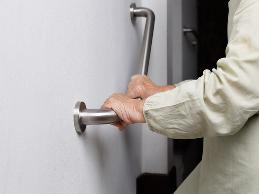On This Page
About Postural Orthostatic Tachycardia Syndrome (POTS)
Postural Orthostatic Tachycardia Syndrome (POTS) is a form of dysfunction of the autonomic nervous system’s ability to regulate heart rate. With POTS, the body is not able to keep heart rate at steady and stable levels. A variety of symptoms are associated with POTS, which may include but are not limited to angina (chest pain sometimes radiating down the left arm or into the jaw); dizziness or lightheadedness that often manifests during periods of prolonged periods of walking, prolonged periods of standing in one static position, or when standing up suddenly from seated positions; syncope (fainting); chronic fatigue; tremors, exercise intolerance; hypo or hypertension, and gastric upset.
Postural Orthostatic Tachycardia Syndrome (POTS) and the Americans with Disabilities Act
The ADA does not contain a definitive list of medical conditions that constitute disabilities. Instead, the ADA defines a person with a disability as someone who (1) has a physical or mental impairment that substantially limits one or more "major life activities," (2) has a record of such an impairment, or (3) is regarded as having such an impairment. For more information about how to determine whether a person has a disability under the ADA, see How to Determine Whether a Person Has a Disability under the Americans with Disabilities Act Amendments Act (ADAAA).
Accommodating Employees with Postural Orthostatic Tachycardia Syndrome (POTS)
People with POTS may develop some of the limitations discussed below, but rarely develop all of them. Also, the degree of limitation will vary among individuals. Be aware that not all people with POTS will need accommodations to perform their jobs and many others may only need a few accommodations. The following is only a sample of the possibilities available should any situation or need arise. Numerous other accommodation solutions may exist.
Questions to Consider:
- What limitations is the employee experiencing?
- How do these limitations affect the employee and the employee’s job performance?
- What specific job tasks are problematic as a result of these limitations?
- What accommodations are available to reduce or eliminate these problems? Are all possible resources being used to determine possible accommodations?
- Once accommodations are in place, would it be useful to meet with the employee to evaluate the effectiveness of the accommodations and to determine whether additional accommodations are needed?
- Do supervisory personnel and employees need training?
Key Accommodations
Decreased Stamina/Fatigue: Individuals with POTS can become fatigued to the extent they cannot work a full shift or perform physical aspects of their role.
- Allow frequent breaks
- Allow flexible scheduling and flexible leave
- Allow work from home
- Implement ergonomic considerations
- Eliminate physical exertion
- Permit a service animal for mobility assistance
Dizziness: Individuals with POTS may experience dizziness or lightheadedness when standing up quickly, standing in place for prolonged periods, or from prolonged walking.
- Provide chairs with armrests and locking casters so that individuals can steady themselves when standing up without worry that the chair will move
- Provide stools or chairs to allow for alternating between standing and sitting
- Allow additional rest breaks or modify when tasks are done to break up periods of prolonged walking
Gross Motor: Individuals with POTS may experience short- or long-term gross motor limitations.
- Implement ergonomic considerations
- Provide equipment: e.g., lifting devices, carts
- Permit the use of mobility aids and/or service animal
Effect of/ Receive Medical Treatment: Individuals with POTS may need time to attend medical appointments or recover from a medical treatment or procedure.
- Allow work from home
- Allow flexible scheduling and flexible leave
Safety Standards: Having POTS does not automatically mean safety hazards will exist, but there may be increased risk in certain work environments or performing certain tasks.
- Consider developing a Plan of Action
- Purchase protective equipment: fall protection, edge cushions, alerting devices, machine guards
Accommodation Ideas:
Situations and Solutions:
The following situations and solutions are real-life examples of accommodations that were made by JAN customers. Because accommodations are made on a case-by-case basis, these examples may not be effective for every workplace but give you an idea about the types of accommodations that are possible.






